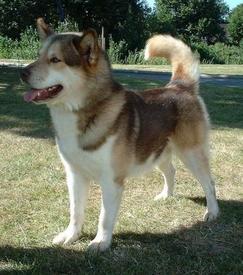
A relatively rare breed, the Greenland Dog or Greenland Husky, falls within the 'working' branch of canines, traditionally utilised in its native land as a versatile haulage dog. The breed has existed in the Arctic region since antiquity and is often mistaken for the Siberian Husky and Alaskan Malamute. Although its exact origin is subject to speculation, it is widely thought that the breed accompanied the Siberian wanderers, later to become the early Inuits, over 12,000 years ago. Principally bred as a working dog, the Greenland Husky was often observed racing with wagons or sleds, or hunting for bears and seals.
A powerful-looking breed, the Greenland Dog possesses a heavy frame, bushy tail, feathered legs and small, triangular ears. Its profuse double coat aids the dog's survival, protecting internal organs from -50 to -75 degree colds. The curved tail serves to shield the dog's face while it is sleeping. Boasting a typically Nordic appearance, the breed is inherently Spitz, primitive in its habits having most likely descended from wolves. The modern Greenland Dog is favoured as a hiking companion in Norway and Sweden.
Typically independent and with a natural tendency to exercise alpha behaviours, the Greenland Dog requires firm leadership and consistent training from an early age. That said, the breed is adaptable to domestic life and is a suitable breed choice for active families or the dedicated sole owner. Loyal, obedient and protective of home and property, the Greenland Dog makes a great addition to any home setting, providing its needs are met. Generally, a healthy Greenland Dog will weigh 30-32 kg, with a life expectancy of 10-12 years when cared for accordingly.
Whilst being typically healthy and resilient, the Greenland Dog is susceptible to a range of genetic diseases, including optical disorders and epilepsy. Documented cases of cataracts, glaucoma and progressive retinal atrophy are numerous in the breed. As with most breeds, hip and elbow dysplasia is frequently observed.
Do you own a Greenland Dog? Let others know what they're like!
Related products
Advantage 80 Spot On Flea Control Large Cats and Rabbits
from £12.95
Advantage 40 Spot On Flea Control Cats, Small Dogs and Rabbits
from £12.95
Advantage 250 Spot On Flea Control Large Dog
from £12.95
Advantage 100 Spot On Flea Control Medium Dog
from £12.95
Drontal Tasty Bone Wormer Tablets for Small & Medium Dogs (2 to 20kg)
from £2.15
TermaWorm™ Tablets for Cats & Dogs
from £1.79
Drontal Tasty Bone XL Wormer Tablets for Large Dogs (Over 20kg)
from £6.39
Advantage 400 Spot On Flea Control Extra Large Dog
from £12.95